The Automotive Engine Management Sensors Market is estimated to be valued at USD 69.0 billion in 2025 and is projected to reach USD 104.1 billion by 2035, registering a compound annual growth rate (CAGR) of 4.2% over the forecast period.
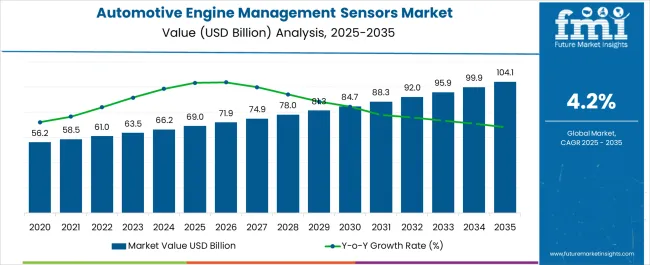
| Metric | Value |
|---|---|
| Automotive Engine Management Sensors Market Estimated Value in (2025 E) | USD 69.0 billion |
| Automotive Engine Management Sensors Market Forecast Value in (2035 F) | USD 104.1 billion |
| Forecast CAGR (2025 to 2035) | 4.2% |
The Automotive Engine Management Sensors market is experiencing significant growth, driven by the increasing demand for vehicle performance optimization, fuel efficiency, and emissions reduction. Growing regulatory pressure on automotive emissions and rising consumer awareness about fuel economy are driving the adoption of advanced engine management sensors. Technological advancements in sensor design, including higher precision, durability, and integration with electronic control units, are enhancing engine performance, safety, and reliability.
Increasing production of passenger cars and commercial vehicles, coupled with the growing popularity of diesel and hybrid engines, is further contributing to market expansion. Sensors are being increasingly deployed to monitor airflow, temperature, pressure, and other engine parameters in real time, enabling predictive maintenance and improved operational efficiency.
As automotive manufacturers continue to focus on compliance with global emission norms and the development of next-generation powertrains, the demand for sophisticated engine management sensors is expected to sustain long-term growth Rising investments in research, development, and smart automotive technologies are supporting further market advancement.
The automotive engine management sensors market is segmented by product type, vehicle type, engine type, and geographic regions. By product type, automotive engine management sensors market is divided into Mass Airflow Sensors, Knock Sensors, Crankshaft Sensors, Camshaft Sensors, Pressure Sensors, and Temperature Sensors. In terms of vehicle type, automotive engine management sensors market is classified into Passenger Cars, HCV, and LCV. Based on engine type, automotive engine management sensors market is segmented into Diesel Engine and Gasoline Engine. Regionally, the automotive engine management sensors industry is classified into North America, Latin America, Western Europe, Eastern Europe, Balkan & Baltic Countries, Russia & Belarus, Central Asia, East Asia, South Asia & Pacific, and the Middle East & Africa.
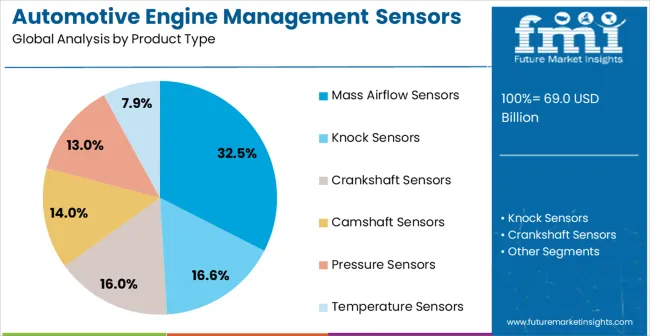
The mass airflow sensors segment is projected to hold 32.5% of the market revenue in 2025, establishing it as the leading product type. Growth is being driven by the critical role these sensors play in measuring the volume and density of air entering the engine, which directly impacts fuel injection accuracy, combustion efficiency, and emissions control. Mass airflow sensors enable real-time data transmission to the engine control unit, optimizing engine performance and reducing fuel consumption.
Increasing adoption in passenger cars, commercial vehicles, and diesel engines is enhancing market demand. Technological improvements, including higher sensitivity, compact design, and integration with advanced engine management systems, have strengthened reliability and accuracy, promoting wider deployment.
Automotive manufacturers are prioritizing these sensors to meet stringent emission regulations and improve overall vehicle performance The combination of cost-effectiveness, efficiency, and compliance support has reinforced the leading position of mass airflow sensors within the engine management sensor product portfolio.
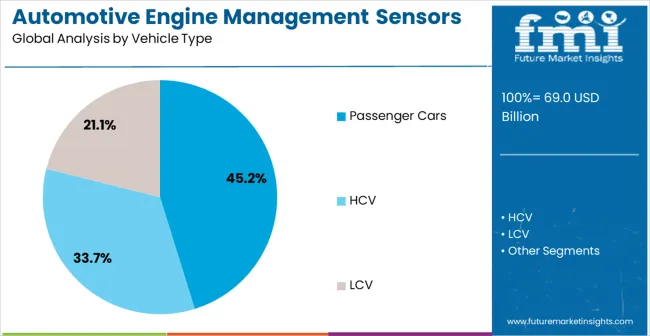
The passenger cars vehicle type segment is expected to account for 45.2% of the market revenue in 2025, making it the leading vehicle category. Growth is being driven by increasing consumer demand for fuel-efficient, low-emission, and high-performance vehicles. Engine management sensors are being widely adopted in passenger cars to optimize combustion, improve drivability, and monitor key engine parameters in real time.
Rising production of passenger vehicles in emerging markets and ongoing fleet modernization programs in developed regions are contributing to expansion. Integration of sensors with electronic control units, onboard diagnostics, and telematics systems enhances operational efficiency and predictive maintenance capabilities.
Regulatory pressure on emission reduction and fuel efficiency compliance further reinforces the adoption of advanced engine management sensors in passenger cars As automotive manufacturers continue to invest in powertrain optimization and emission control technologies, the passenger cars segment is expected to maintain its market leadership, driven by performance enhancement, regulatory compliance, and consumer preference for technologically advanced vehicles.
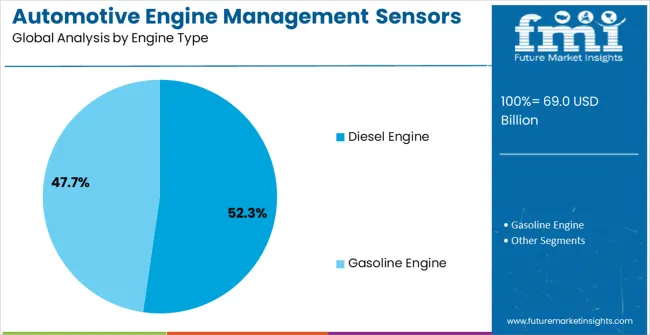
The diesel engine type segment is projected to hold 52.3% of the market revenue in 2025, establishing it as the leading engine category. This growth is being driven by the widespread use of diesel engines in passenger vehicles, commercial vehicles, and industrial applications, where efficiency and torque performance are critical. Engine management sensors for diesel engines enable precise monitoring of airflow, temperature, pressure, and exhaust parameters, ensuring optimal combustion, reduced emissions, and improved fuel efficiency.
Adoption is further supported by stringent emission norms for nitrogen oxides and particulate matter, which require advanced sensor integration for compliance. Technological innovations in sensor accuracy, durability, and integration with engine control units have strengthened reliability and performance in diesel engines.
Manufacturers are increasingly prioritizing these sensors to meet regulatory requirements and optimize engine performance across diverse operating conditions As demand for energy-efficient, high-performance diesel engines continues to rise, this segment is expected to maintain its leading position within the Automotive Engine Management Sensors market.
Automotive engine management sensors are devices which convert one form of energy into electric signal and enable engine electronic system to have an appropriate interface with the engine mechanical parts. Automotive engine management sensors enhance the engine efficiency by assisting in control of various parameters which affect the engine performance.
There are multiple type of engine sensors available in the market, which capture various types of engine data. A mass airflow sensor is utilized for supply of information related to humidity, temperature and intake air volume. This information is then utilized for regulation of fuel supply in gasoline engines and regulate exhaust gas recirculation rate in case of diesel engine.
Moreover, camshaft sensor determines the position of camshaft. This information is further utilized for initiating injection on sequential injection engines. Automotive Engine Management Sensors are usually subjected to random errors, such as vibration, electrical noise and heat.
Furthermore, automotive engine management sensors are also employed for capturing the engine crankshaft position which further helps in determining the most economical fuel ignition timing of the vehicle. Automotive engine management sensors are the best alternatives for monitoring the engine performance, due to this they are extensively used along with actuators and ECU for capturing engine information and to improve the overall engine performance.
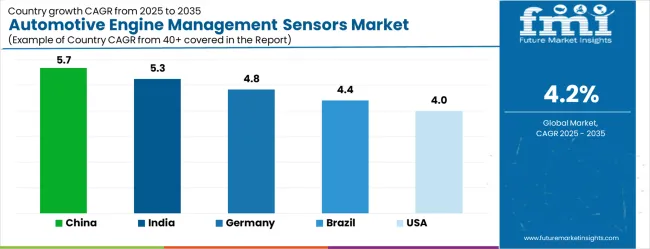
| Country | CAGR |
|---|---|
| China | 5.7% |
| India | 5.3% |
| Germany | 4.8% |
| Brazil | 4.4% |
| USA | 4.0% |
| UK | 3.6% |
| Japan | 3.2% |
The Automotive Engine Management Sensors Market is expected to register a CAGR of 4.2% during the forecast period, exhibiting varied country level momentum. China leads with the highest CAGR of 5.7%, followed by India at 5.3%. Developed markets such as Germany, France, and the UK continue to expand steadily, while the USA is likely to grow at consistent rates. Japan posts the lowest CAGR at 3.2%, yet still underscores a broadly positive trajectory for the global Automotive Engine Management Sensors Market. In 2024, Germany held a dominant revenue in the Western Europe market and is expected to grow with a CAGR of 4.8%. The USA Automotive Engine Management Sensors Market is estimated to be valued at USD 25.2 billion in 2025 and is anticipated to reach a valuation of USD 25.2 billion by 2035. Sales are projected to rise at a CAGR of 0.0% over the forecast period between 2025 and 2035. While Japan and South Korea markets are estimated to be valued at USD 3.2 billion and USD 2.1 billion respectively in 2025.

| Item | Value |
|---|---|
| Quantitative Units | USD 69.0 Billion |
| Product Type | Mass Airflow Sensors, Knock Sensors, Crankshaft Sensors, Camshaft Sensors, Pressure Sensors, and Temperature Sensors |
| Vehicle Type | Passenger Cars, HCV, and LCV |
| Engine Type | Diesel Engine and Gasoline Engine |
| Regions Covered | North America, Europe, Asia-Pacific, Latin America, Middle East & Africa |
| Country Covered | United States, Canada, Germany, France, United Kingdom, China, Japan, India, Brazil, South Africa |
| Key Companies Profiled | Robert Bosch GmbH, Continental AG, BorgWarner Inc., DENSO Corporation, Hella KGaA Hueck & Co., Infineon Technologies AG, Sensata Technologies, Mobiletron Electronics Co. Ltd, NGK Spark Plugs Pvt Ltd., Hitachi Automotive Systems Ltd, and Dover Corporation |
The global automotive engine management sensors market is estimated to be valued at USD 69.0 billion in 2025.
The market size for the automotive engine management sensors market is projected to reach USD 104.1 billion by 2035.
The automotive engine management sensors market is expected to grow at a 4.2% CAGR between 2025 and 2035.
The key product types in automotive engine management sensors market are mass airflow sensors, knock sensors, crankshaft sensors, camshaft sensors, pressure sensors and temperature sensors.
In terms of vehicle type, passenger cars segment to command 45.2% share in the automotive engine management sensors market in 2025.






Full Research Suite comprises of:
Market outlook & trends analysis
Interviews & case studies
Strategic recommendations
Vendor profiles & capabilities analysis
5-year forecasts
8 regions and 60+ country-level data splits
Market segment data splits
12 months of continuous data updates
DELIVERED AS:
PDF EXCEL ONLINE
Automotive Roof Rails Market Size and Share Forecast Outlook 2025 to 2035
Automotive Active Safety System Market Size and Share Forecast Outlook 2025 to 2035
Automotive Diagnostic Scan Tool Market Size and Share Forecast Outlook 2025 to 2035
Automotive Test Equipment Market Size and Share Forecast Outlook 2025 to 2035
Automotive Dynamic Map Data Market Size and Share Forecast Outlook 2025 to 2035
Automotive Green Tires Market Size and Share Forecast Outlook 2025 to 2035
Automotive E-Tailing Market Size and Share Forecast Outlook 2025 to 2035
Automotive Interior Market Forecast Outlook 2025 to 2035
Automotive Key Market Size and Share Forecast Outlook 2025 to 2035
Automotive Appearance Chemical Market Forecast and Outlook 2025 to 2035
Automotive Seating Market Forecast and Outlook 2025 to 2035
Automotive Domain Control Module Market Forecast and Outlook 2025 to 2035
Automotive Remote Diagnostic Market Forecast and Outlook 2025 to 2035
Automotive-grade Inertial Navigation System Market Size and Share Forecast Outlook 2025 to 2035
Automotive Thin IGBT Module Market Size and Share Forecast Outlook 2025 to 2035
Automotive Hybrid IGBTs Market Size and Share Forecast Outlook 2025 to 2035
Automotive Exhaust Extraction Hose Reels Market Size and Share Forecast Outlook 2025 to 2035
Automotive Electroplating Service Market Size and Share Forecast Outlook 2025 to 2035
Automotive Manufacturing Equipment Market Size and Share Forecast Outlook 2025 to 2035
Automotive Pressure Sensor Market Size and Share Forecast Outlook 2025 to 2035

Thank you!
You will receive an email from our Business Development Manager. Please be sure to check your SPAM/JUNK folder too.
Chat With
MaRIA